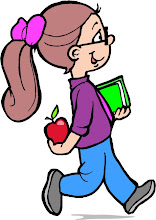Now that we have completed learning the blends, I wrote a story and used clip art to illustrate it. After K. has read it a few times we will be on to learn the clusters.
I've grouped the clusters this way:
- ar, er, ir, or, ur
- ch, sh, th
- aw, ew, ow, oo (as in spoon)
- oy, oi, ou, oo (as in book)
- ing, ang, ong, tion
Children know how to say these clusters -- they use words with them all the time -- however, they don't know what letters make the sounds. Using this reasoning, this is how I'm introducing the clusters (I'll use 'ar' in this example):
- Show a picture of a car and ask K. what it is.
- K. tells me "car"
- I write "car" next to the picture
- We sound out the word: k - ar
- I bring attention to the sound of 'ar'
- We use the letter cards to build more words which contain 'ar'. Here are some examples: hard, card, far, jar, mark, lark
If I want K. to have more practice:
I can write the words we build on a sheet of paper for us to review.
To spread phonics over the whole week, and since she enjoys cutting and gluing, I can also write the words on a paper (or each on a card) and K. can find pictures of the items and glue them next to the word.
Another idea is to write some sentences K. can read after each group of clusters is learned. They might be silly like "Her car is full of fur." K. could illustrate the sentences.
After learning the clusters there will be another book to read.

No comments:
Post a Comment